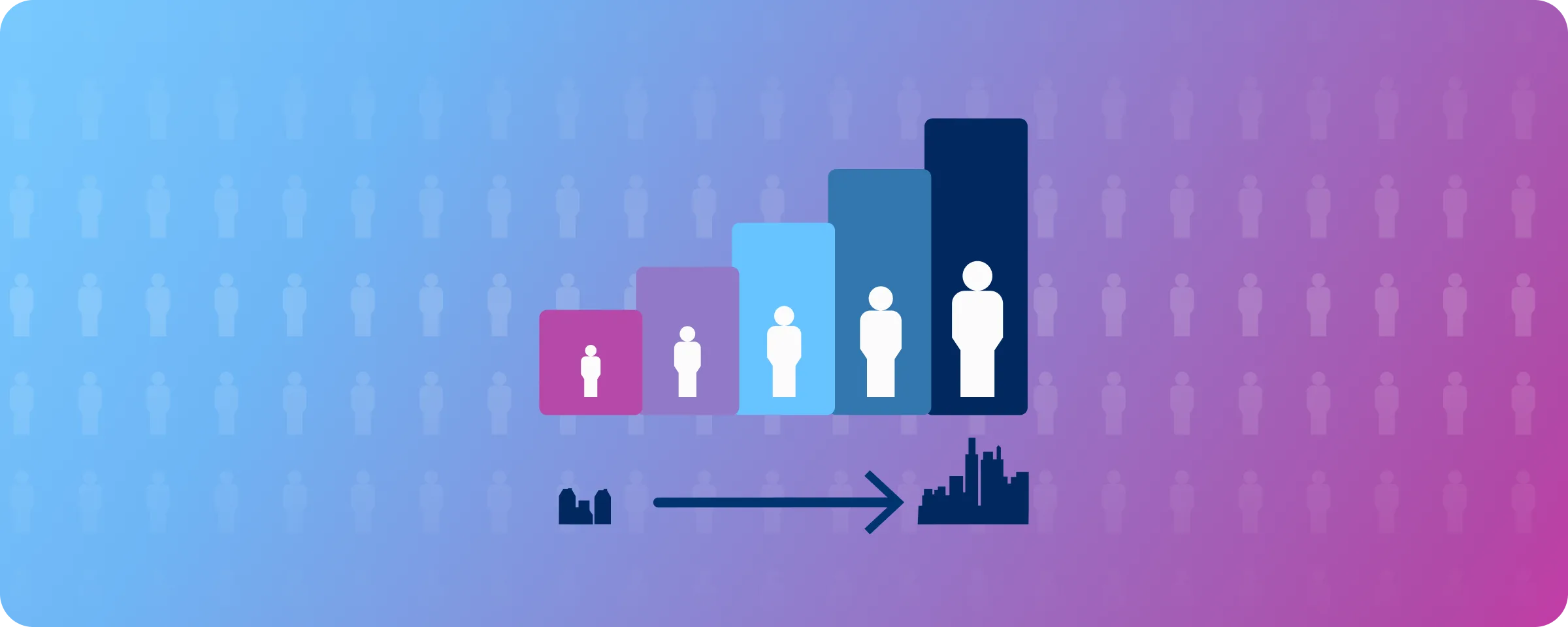Key Takeaways
- “Average city population” is misleading due to vast global variation in city sizes and definitions.
- Urban growth and decline trends reshape markets, and averages can hide these dynamics.
- Granular, location-specific data outperforms broad averages for decisions in retail, insurance, and planning.
- Understanding cities means moving beyond averages—only detailed, localized data can capture the real-world complexity that drives smart decisions.
Why ‘Average City Population’ is Misleading Your Business Decisions
With the global urban population projected to grow by 2.5 billion by 2050, primarily concentrated in Asian megacities such as Tokyo, Delhi, and Shanghai, understanding city demographics is crucial for effective infrastructure planning and informed business strategy.
- City populations range from small towns (<5,000 residents) to megacities (>10 million), each with distinct infrastructure needs and economic profiles. This vast range exists due to different civilizations and development patterns across the globe.
- These extremes demonstrate why the “average city population” is misleading – Tokyo (37M) and a Swiss mountain town (5,000) can’t be meaningfully averaged.
These dynamics directly impact public service delivery (transport/housing) and commercial decisions like retail site selection and insurance risk modeling.
This statistical distortion becomes even more problematic when you consider that the city definition—and what qualifies as a “city” or “urban area”—varies greatly from one country to another.
Defining Urban Areas
The United Nations defines urban areas as cities and their surrounding areas, which are well-developed, often with a high density of infrastructure, public services, and a large population. It is important to note that the definition can vary between countries.
The lack of universal standards means “average population” calculations must specify whether they include suburbs or measure core cities only.
Urban areas can be classified into different types, including metropolitan areas and cities, each with unique characteristics:
- Metropolitan Areas: Large, densely populated urban cores and their surrounding economically integrated areas. A prime example is London (9.5 million people), which doesn’t exist as a single “place” within England’s fine-grained administrative divisions but spans 33 boroughs, though users commonly search for “London”.
- Cities: Defined by population thresholds, historical charters, or administrative designations that vary widely by country. For example, Medellín, Colombia, appears multiple times among the world’s most densely populated postal codes—some exceeding 20,000 residents/km². While not all such areas are officially cities, Medellín highlights how high density often aligns with what is perceived as urban, underscoring the ambiguity in defining a city.
The Census Bureau and other organizations collect and distribute population data and estimates based on many factors, such as urbanization degree and economic growth, to help define urban areas, which is essential for development and planning.
To avoid confusion in the rest of this article, we will refer to all of these as cities.
City and Town Population Dynamics
Population growth & decline examples
- Growth: Cities like Dubai, UAE have seen a +200% population increase since 2025, while Austin, USA, experienced a +35% growth between 2025 and 2025 due to job opportunities, tech industries, and migration.
- Decline: Detroit, USA saw a -65% population crash since 2025 due to the automotive industry collapse. Eastern European towns like Aluksne, Latvia, have declined due to low birth rates and youth emigration.
Why It Matters: Tracking these shifts helps businesses predict market demand, governments allocate resources efficiently, and investors identify growth hotspots or revitalization opportunities.
These changes make “average population” a moving target – today’s boom town becomes tomorrow’s average city.
Daytime vs. Nighttime Population
- Daytime populations swell in business districts (e.g., Manhattan, London’s Square Mile) as commuters arrive, as well as retail and restaurant staff who often don’t live in the area. This is particularly relevant for job concentration.
- Nighttime populations reflect residential areas, influencing housing and local infrastructure needs, such as schools and hospitals.
| Location | Nighttime | Daytime |
|---|---|---|
| Manhattan, NYC | 1.63 million | 3.94 million |
| London Square Mile | 9,400 | 513,000 |
Why this matters: Cities use this dual view to right-size rush-hour transit while planning schools and housing where people live, preventing wasteful resource gaps.
This daily fluctuation means population “averages” must specify whether they count residents or total daily occupants.
💡 Stop making decisions with outdated population data. GeoPostcodes provides accurate, up-to-date global population data at ZIP code-level. Get a demo.
How Population Projections Work
Population projections are the result of global scientific collaboration, relying on two key pillars: core data sources and advanced modeling methodology.
Core data sources:
- National Censuses: For example, U.S. Decennial Census, India’s National Population Register
- Harmonized International Datasets: For example, European Commission’s Demographic Balance (Eurostat), which tracks births, deaths, and migrations across more than 30 countries
- Vital Registration Systems: Real-time birth and death records from official certificates
- Satellite & GIS Data: Used to monitor urban sprawl and settlement patterns (e.g., NASA and ESA imagery)
Modelling methodology:
- Cohort-component models: Statistical systems apply survival rates by age and gender to forecast population changes
- Machine learning analysis: Identifies migration patterns driven by factors such as conflict or economic shocks
- Policy-adjusted scenarios: Incorporate the effects of government policies (for example, China’s former one-child policy)
Business Use Cases: Leveraging Population Data
Urban Planning & Land Use
Challenge
Infrastructure planned solely for administrative boundaries often ignores where people actually live and work. This can lead to mismatches between where infrastructure is built and where it is truly needed. This leads to:
- Overbuilt roads in declining areas
- School shortages in high-growth suburbs
- Transit gaps between residential and job zones
Solution
For better urban planning, cities combine:
- Nighttime data (residential density) → Targets housing, schools, hospitals
- Daytime surges (commuter flows) → Guides transit, roads, and utilities
Proven impact
The European Commission’s “Degree of Urbanisation” framework employs this dual approach to allocate over € 50 billion in annual cohesion funds.
Infrastructure must serve actual populations, not statistical averages.
Insurance Risk Modeling
Challenge
Traditional models, such as catastrophe risk modelling, fail when:
- Vacant buildings increase in depopulating towns (higher fire/theft risk)
- Daytime crowds inflate liability exposure (e.g., business districts)
- Climate migration abruptly shifts risk pools
Solution
Actuaries now integrate:
- Long-term residential trends → Price premiums for vacancy risks
- Commuter density maps → Adjust business/liability coverage
Unlike simple averages, this approach captures the dynamic reality of urban populations.
Retail Expansion
Challenge
Revenue plummets when stores are:
- In residential areas with low daytime activity
- Near-declining populations with reduced spending power
- Absent from commuter corridors with peak foot traffic
Solution
To optimize site selection, successful chains prioritize:
- Daytime hotspots (business districts, transport hubs)
- Growth projections (future residential clusters)
- Income/density cross-analysis (e.g., high-earner commuter zones)
- Global standard: UN-Habitat recommends retail site selection in areas with >5,000 daytime persons/km²
This precision targeting outperforms decisions based on city-wide averages.
Conclusion: Beyond the Average
The search for an “average city population” reveals a fundamental truth: meaningful urban insights come from understanding distributions, not arithmetic means. As we’ve seen:
- City population ranges from tiny towns (<5,000) to megacities (>10M)
- Daily fluctuations create daytime/nighttime population differentials of 300%+
- Growth/decline trends constantly reshape urban landscapes
- Practical applications demand granular data, not broad averages
The real value lies in recognizing that every city is unique, from Medellín’s hyper-dense ZIP codes to Detroit’s population collapse. For businesses, governments, and planners, success comes from embracing this complexity rather than seeking oversimplified averages.
With more than 15 years of experience in Enterprise integration and in-depth knowledge of each country’s postal structure, GeoPostcodes offers the highest-quality population data. Request documentation for free and get a demo.
FAQs
What defines an urban area?
Urban areas include cities and nearby developed zones with dense infrastructure and population.
Definitions vary by country.
What’s the difference between a city and a metropolitan area?
Cities are often single administrative units, while metropolitan areas include a central city and its economically linked suburbs.
Why do population changes matter?
They help businesses plan markets, governments allocate resources, and investors spot growth or decline areas.
Can a city’s population change during the day?
Yes.
Daytime populations can be much higher due to commuters, especially in business districts like Manhattan or London’s Square Mile.
Why track both daytime and nighttime populations?
Daytime data helps plan transport and services for workers, while nighttime data guides housing, schools, and healthcare needs.
How is city population data collected?
From censuses, satellite data, migration records, and models that factor in births, deaths, and movement trends.
What are common population modeling methods?
Cohort-component models, machine learning on migration, and policy-based projections are widely used.
How is population data used in city planning?
It informs where to build infrastructure like roads, schools, or transit based on where people live and work—not just administrative borders.
How does population data help in insurance?
It helps assess risk based on vacant buildings, daytime crowd levels, and changing climate-related migration.





